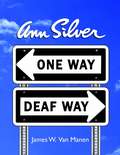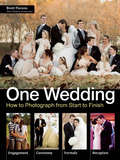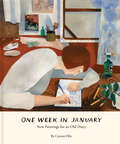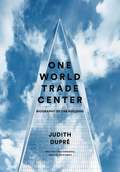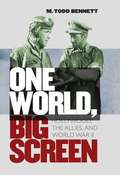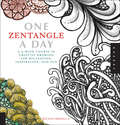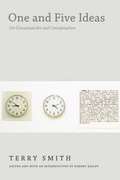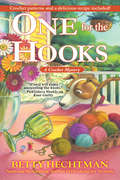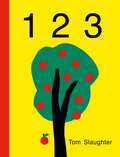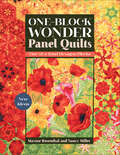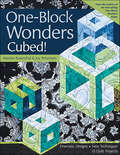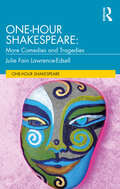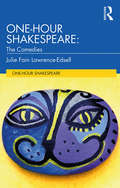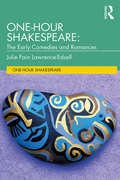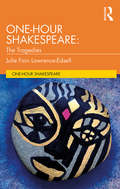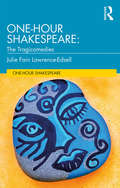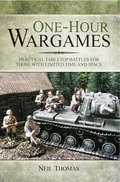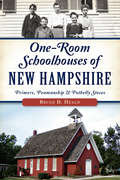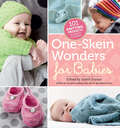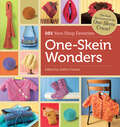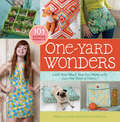- Table View
- List View
One Way, Deaf Way
by James W. Van Manen Ann SilverTo say that Ann Silver is a remarkable person is to miss the mark. While barely 20 years old Ann Silver along with a few others started the Deaf Art Movement. By age 40 she had created an international symbol of sign language interpreting and had her design work published on over 2000 book covers. Five years later after rededicating her life to studio art Silver had completed over 150 pieces and defined a new art genre Deaf Pop Art. This book leads the reader through the life and art of this incredible Deaf artist.
One Wedding
by Brett FlorensEvery wedding is a journey; it starts off slowly many months before the "big day" and starts to accelerate as the auspicious occasion draws closer, with frenetic activity, unforeseen problems, and heightened emotions causing bumps and swerves along the road. When the day dawns, the hill to climb in the hours ahead can seem arduous, or for the über-prepared and relaxed, it could simply be plain sailing. And once the formalities are over and the party gets started, it's usually a speedy downhill ride from there! Photographers tasked with the job of recording the events of the day need to make this journey as pleasant as possible for the clients. Of course, this is no small task. In this book, Brett Florens takes readers step by step through one entire wedding, offering tips to smooth the rocky road for their clients. He provides a play-by-play look at all of the photographic tasks of the day, from the pre-shoot production procedures (engaging with the client about the look and feel of the shoot, developing a mood board [a collection of images, colors, etc. that will inspire the images]), to the engagement shoot, through to the post-wedding shoot and the compilation of the wedding album. He explains, in simple language, how he executed each aspect of the shoot and created the storytelling wedding album. He also discusses his equipment selection and the reasons why he opts to use the tools he selects. Because marketing is essential when trying to attract a specific client, he outlines surefire techniques for identifying, attracting, and securing your target market, allowing you carte blanche to create images and storybooks that reflect your vision and unique interpretation of the event.
One Wedding
by Brett FlorensEvery wedding is a journey; it starts off slowly many months before the "big day" and starts to accelerate as the auspicious occasion draws closer, with frenetic activity, unforeseen problems, and heightened emotions causing bumps and swerves along the road. When the day dawns, the hill to climb in the hours ahead can seem arduous, or for the über-prepared and relaxed, it could simply be plain sailing. And once the formalities are over and the party gets started, it's usually a speedy downhill ride from there! Photographers tasked with the job of recording the events of the day need to make this journey as pleasant as possible for the clients. Of course, this is no small task. In this book, Brett Florens takes readers step by step through one entire wedding, offering tips to smooth the rocky road for their clients. He provides a play-by-play look at all of the photographic tasks of the day, from the pre-shoot production procedures (engaging with the client about the look and feel of the shoot, developing a mood board [a collection of images, colors, etc. that will inspire the images]), to the engagement shoot, through to the post-wedding shoot and the compilation of the wedding album. He explains, in simple language, how he executed each aspect of the shoot and created the storytelling wedding album. He also discusses his equipment selection and the reasons why he opts to use the tools he selects. Because marketing is essential when trying to attract a specific client, he outlines surefire techniques for identifying, attracting, and securing your target market, allowing you carte blanche to create images and storybooks that reflect your vision and unique interpretation of the event.
One Week in January: New Paintings for an Old Diary
by Carson Ellis“Feels like reading a love story that doesn't quite know it's a love story yet, and a success story that doesn't know it’s made it.” —Emma Straub, New York Times–bestselling author of This Time Tomorrow Award-winning, beloved children's book author and illustrator Carson Ellis makes a stunning adult debut with an illustrated memoir that evocatively captures a specific cultural moment of the early 2000s and in her journey as an artist. In January 2001, the young artist Carson Ellis moved into a warehouse in Portland, Oregon, with a group of fellow artists. For the first week she lived there, she kept a detailed diary full of dry observations, mordant wit, hijinks with friends (including her future husband, Decemberists frontman Colin Meloy), and turn-of-the-millennium cultural touchstones. Now, Ellis has richly illustrated this two-decade-old journal with extraordinary new paintings in the signature style that has made her an award-winning picture book author today. This beautiful volume offers a snapshot of a bygone era, a meticulous re-creation of quotidian frustrations and small, meaningful moments, and a meditation on what it means both to start your journey as an artist and to look back at that beginning many years later.AWARD-WINNING AUTHOR: Carson Ellis is a Caldecott award-winning author and artist known for her work in the Wildwood Chronicles, The Mysterious Benedict Society, and beyond and the longtime illustrator-in-residence for the band The Decemberists. People who love her children’s books will be thrilled to discover this new book—especially parents who are nostalgic for the days of the early 2000s. A NOSTALGIC GIFT: One Week in January is the perfect nostalgic gift for anyone who came of age in the heyday of indie rock, offering a glimpse into the lives of a particular Portland art scene. BEAUTIFUL, ECCENTRIC, AND CHARMING: Dry, specific, mundane, and somehow completely magical—this book is a true revelation. With gorgeous one-of-a-kind paintings by the one-and-only Carson Ellis, it’s transporting and relatable, an unglamorous homage to youthful misadventure, fun, sadness, and all the intense feelings of early adulthood.Perfect for: Fans of Carson Ellis’s picture books and illustration People who grew up listening to The Decemberists and other bands from the 90s Portland music scene Millennials and Gen Xers Readers of diaries and memoir Art book collectors
One World Trade Center: Biography of the Building
by Judith Dupr¿The behind-the-scenes story of the most extraordinary building in the world, from the bestselling author of SkyscrapersIn this groundbreaking history, bestselling author Judith Dupré chronicles the most astonishing architectural project in memory: One World Trade Center.The new World Trade Center represents one of the most complex collaborations in human history. Nearly every state in the nation, a dozen countries around the world, and more than 25,000 workers helped raise the tower, which consumed ninety million pounds of steel, one million square feet of glass, and enough concrete to pave a sidewalk from New York to Chicago. With more than seventy interviews with the people most intimately involved, and unprecedented access to the building site, suppliers, and archives, Dupré unfurls the definitive story of fourteen years of conflict and controversy-and its triumphant resolution. This fascinating, oversize book delivers new insight into the 1,776-foot-tall engineering marvel, from design and excavation through the final placement of its spire. It offers:Access to the minds of world-class architects, engineers, ironworkers, and other tradespeoplePanoramas of New York from One World Observatory-1,268 feet above the earthDramatic cutaways that show the building's advanced structural technologiesA time-lapse montage showing the evolution of the sixteen-acre site Chronologies tracking design, construction, and financial milestones, with rare historic photographsIt also features extensive tour of the entire Trade Center, including in-depth chapters on Two, Three, Four, and Seven World Trade Center; the National September 11 Memorial & Museum; Liberty Park; St. Nicholas National Shrine; and the soaring Transportation Hub. One World Trade Center is the only book authorized by the Port Authority of New York & New Jersey, and the one book necessary to understand the new World Trade Center in its totality. This is a must-have celebration of American resilience and ingenuity for all who are invested in the rebuilding of Ground Zero.You may be surprised by what you find inside-and you will undoubtedly be inspired.
One World, Big Screen
by M. Todd BennettWorld War II coincided with cinema's golden age. Movies now considered classics were created at a time when all sides in the war were coming to realize the great power of popular films to motivate the masses. Through multinational research, One World, Big Screen reveals how the Grand Alliance--Britain, China, the Soviet Union, and the United States--tapped Hollywood's impressive power to shrink the distance and bridge the differences that separated them. The Allies, M. Todd Bennett shows, strategically manipulated cinema in an effort to promote the idea that the United Nations was a family of nations joined by blood and affection. Bennett revisits Casablanca, Mrs. Miniver, Flying Tigers, and other familiar movies that, he argues, helped win the war and the peace by improving Allied solidarity and transforming the American worldview. Closely analyzing film, diplomatic correspondence, propagandists' logs, and movie studio records found in the United States, the United Kingdom, and the former Soviet Union, Bennett rethinks traditional scholarship on World War II diplomacy by examining the ways that Hollywood and the Allies worked together to prepare for and enact the war effort.
One Wrong Turn
by Chenée MarrapodiIf I wanted the lead role, Valentina had to go. A contemporary Ballet Shoes set in an elite dance academy, this compelling coming-of-age novel is all about overcoming pressure, standing up for yourself and the joy of ballet! The perfect gift for all young dancers.Amelia is a ballerina on the rise – she' s talented, dedicated and set to star in the lead role of the annual production. But when Valentina arrives from Italy and joins the ballet academy, the competition gets fierce.
One Zentangle a Day: A 6-Week Course in Creative Drawing for Relaxation, Inspiration, and Fun (One A Day Ser.)
by Beckah KrahulaTake your doodles—and your mind—to a whole new level with this bestselling and preeminent guidebook to the meditative art of the Zentangle.The Zentangle method was created by Rick Roberts and Maria Thomas as a way to practice focus and meditation through drawing by using repetitive lines, marks, circles, and shapes. Each mark is called a “tangle,” and you combine various tangles into patterns to create “tiles,” or small square drawings.Each of the six chapters explores a different aspect of Zentangle:Basics and EnhancementsTangles and Value PatternsGeometric and Organic PatternsUnderstanding and Using ColorDefining and Using StyleCreating the Rest of Your Zentangle JourneyEach exercise includes new tangles to draw in sketchbooks or on Tiepolo (an Italian-made paper), teaches daily tile design, offers tips on related art principles, and contains an inspirational “ZIA” (Zentangle Inspired Art) project on a tile that incorporates patterns, art principals, and new techniques.Drawing Zentangles is a relaxing and replenishing diversion that can be enjoyed by people of all ages and skill levels. In addition to its soothing benefits, a Zentangle practice can also help with self-image, phobias, addictions, pain management, conflict resolution, and coping with grief.Step away from the daily hustle and untangle with a Zentangle.
One and Five Ideas: On Conceptual Art and Conceptualism
by Terry Smith Robert BaileyIn One and Five Ideas eminent critic, historian, and former member of the Art & Language collective Terry Smith explores the artistic, philosophical, political, and geographical dimensions of Conceptual Art and conceptualism. These four essays and a conversation with Mary Kelly—published between 1974 and 2012—contain Smith's most essential work on Conceptual Art and his argument that conceptualism was key to the historical transition from modern to contemporary art. Nothing less than a distinctive theory of Conceptual and contemporary art, One and Five Ideas showcases the critical voice of one of the major art theorists of our time.
One for the Hooks: A Crochet Mystery (A Crochet Mystery #14)
by Betty HechtmanMolly Pink and the Tarzana Hookers must unwind a fiendish skein in national bestselling author Betty Hechtman's fourteenth Crochet mystery.These are the dog days of August, but you won't catch the Tarzana Hookers crochet club napping. While Molly Pink knits together an idea for a new project, Miami Wilson busily converts a house she inherited into a rental property. But Miami is left shorthanded when Sloan Renner, the woman helping her clean out the house ends up dead under a pile of smelly seafood.A large drone had flown over the property discarding mollusk shells all over the backyard. Was it an accident? An ill-fated prank by neighbors up in arms about a rental house in their cul-de-sac? Witnesses clam up when Molly's ex, homicide detective Barry Greenberg, tries to get information, but he thinks Molly may be able to get them to open up to her.When Molly learns about Sloan's seafood allergy, she suspects that the woman's death was no accident. Can she bait the hook to catch the culprit, or will the killer keep raising shell?
One, Two, Three
by Tom SlaughterCreated in deceptively simple paper cuts, this is a counting book with a difference: each image is not only an introduction to numerals but also to the shapes and colors of modern art. Small children, and those with an interest in modern art, will find much to enjoy in this gorgeous picture book.Tom Slaughter’s vibrant prints are in the collection of the Museum of Modern Art and the Whitney Museum. This, his first children’s book, was inspired by the paper cuts of Matisse, Dick Bruna, the art of his late brother-in-law – the renowned fabric artist, Tim Jocelyn – as well as the work of his wife, Marthe Jocelyn, creator of Hannah and the Seven Dresses and Hannah’s Collections.
One-Block Wonder Panel Quilts: New Ideas; One-of-a-Kind Hexagon Blocks
by Nancy Miller Maxine RosenthalLearn how to create amazing one-block wonder quilts with beautiful kaleidoscope designs.Pick one great fabric to create a stunning blockOne-Block Wonder expert and best-selling author Maxine Rosenthal, along with fellow quilter Nancy Miller, teach quilters the endless ways to turn preprinted fabric panels into fabulous blocks. Learn how to arrange One-Block Wonder hexagons around a panel, how to blend hexagon colors into the panel, and how to sew it all together. Includes easy-to-follow instructions, no y-seams, and an end result with gorgeous visual effects!Make remarkable kaleidoscope designs by cutting and sewing triangles into hexagonsUse fabric panels in a beautiful way—each block is unique to youSimple piecing with NO Y-SEAMS!
One-Block Wonders Cubed!: Dramatic Designs, New Techniques, 10 Quilt Projects
by Maxine Rosenthal Joy PelzmannAdd New Dimension to Your Favorite Hexagon Quilts • Your favorite One-Block Wonders authors are back with new graphic techniques using triangles, cubes, and appliqué • Learn how to create optical illusions with your fabrics • Bonus projects include totes, coasters and placemats for using up left-over hexagons • Create interesting shadow effects with clever fabric placement • Try new kinds of borders with uneven edges, creative shapes, and hexagon strips From the best-selling authors of the One-Block Wonders books. New techniques and design strategies using simple geometric shapes give you dramatic quilt imagery that seems to defy logic! Take the ordinary and turn it into something extraordinary with this book.
One-Block Wonders of the World: New Ideas, Design Advice, A Stunning Collection of Quilts
by Maxine Rosenthal Linda BardesOne fabric, one quilt! Magical kaleidoscopes from pieced hexagons Transform a single fabric print with marvelous piecing magic! Best-selling author Maxine Rosenthal and Linda Bardes share stunning One Yard Wonders quilts, with contributions from their popular Facebook design community. Learn how to choose the right 60-degree ruler, pick the most useful fabric, and change the look of a quilt with a different strip size. See what others have done - the beginning fabric and the ending projects - and courageously cut into that beautiful yardage! Sew simple pieced hexagon blocks with no "Y" seams, and enjoy the thrill of arranging and rearranging them on your design wall. • Fantastic transformations! Turn one fabric print into a kaleidoscope quilt with this visual guide • Learn to cut and piece identical triangles, arrange blocks on the design wall, and design borders • Admire 30 One Block Wonders, the original uncut fabric, and strip width needed to cut your own • Quilt with best-selling author Maxine Rosenthal, Linda Bardes, and international quilters from their popular Facebook design group
One-Hour Shakespeare: More Comedies and Tragedies (One-Hour Shakespeare)
by Julie Fain Lawrence-EdsellThe One-Hour Shakespeare series is a collection of abridged versions of Shakespeare’s plays, designed specifically to accommodate both small and large casts. This volume, More Comedies and Tragedies, includes the following plays: The Comedy of Errors The Taming of the Shrew Antony and Cleopatra King Lear These accessible and versatile scripts are supported by: an introduction with emphasis on the evolution of the series and the creative process of editing; the One-Hour projects in performance, a chapter on implementing money-saving ideas and suggestions for production whether in or outside of a classroom setting; specific lesson plans to incorporate these projects successfully into an academic course; suggested casting assignments for small to large casts; the how-tos of producing a radio play; and cross-gender casting suggestions. These supplementary materials make the plays valuable not only for actors, but for any environment, cast or purpose. Ideal for both academics and professionals, One-Hour Shakespeare is the perfect companion to teaching and staging the most universally read and performed playwright in history.
One-Hour Shakespeare: The Comedies (One-Hour Shakespeare)
by Julie Fain Lawrence-EdsellThe One-Hour Shakespeare series is a collection of abridged versions of Shakespeare’s plays, designed specifically to accommodate both small and large casts. This volume, The Comedies, includes the following plays: As You Like It Love’s Labour’s Lost Much Ado About Nothing Twelfth Night These accessible and versatile scripts are supported by: an introduction with emphasis on the evolution of the series and the creative process of editing; the One-Hour projects in performance, a chapter on implementing money-saving ideas and suggestions for production whether in or outside a classroom setting; specific lesson plans to incorporate these projects successfully into an academic course; and cross-gender casting suggestions. These supplementary materials make the plays valuable not only for actors, directors and professors, but for any environment, cast or purpose. Ideal for both academics and professionals, One-Hour Shakespeare is the perfect companion to teaching and staging the most universally read and performed playwright in history.
One-Hour Shakespeare: The Early Comedies and Romances (One-Hour Shakespeare)
by Julie Fain Lawrence-EdsellThe One-Hour Shakespeare series is a collection of abridged versions of Shakespeare’s plays, designed specifically to accommodate both small and large casts. This volume, The Early Comedies and Romances, includes the following plays: A Midsummer Night’s Dream Two Gentlemen of Verona The Tempest The Winter’s Tale. These accessible and versatile scripts are supported by: an introduction with emphasis on the evolution of the series and the creative process of editing; the One-Hour projects in performance, a chapter on implementing money-saving ideas and suggestions for production whether in or outside a classroom setting; specific lesson plans to incorporate these projects successfully into an academic course; and cross-gender casting suggestions. These supplementary materials make the plays valuable not only for actors, directors and professors, but for any environment, cast or purpose. Ideal for both academics and professionals, One-Hour Shakespeare is the perfect companion to teaching and staging the most universally read and performed playwright in history.
One-Hour Shakespeare: The Tragedies (One-Hour Shakespeare)
by Julie Fain Lawrence-EdsellThe One-Hour Shakespeare series is a collection of abridged versions of Shakespeare’s plays, designed specifically to accommodate both small and large casts. This volume, The Tragedies, includes the following plays: Hamlet Julius Caesar Macbeth Othello Romeo and Juliet These accessible and versatile scripts are supported by: an introduction with emphasis on the evolution of the series and the creative process of editing; the One-Hour projects in performance, a chapter on implementing money-saving ideas and suggestions for production, whether in or outside a classroom setting; specific lesson plans to incorporate these projects successfully into an academic course; and cross-gender casting suggestions. These supplementary materials make the plays valuable not only for actors, directors and professors, but for any environment, cast or purpose. Ideal for both academics and professionals, One-Hour Shakespeare is the perfect companion to teaching and staging the most universally read and performed playwright in history.
One-Hour Shakespeare: The Tragicomedies (One-Hour Shakespeare)
by Julie Fain Lawrence-EdsellThe One-Hour Shakespeare series is a collection of abridged versions of Shakespeare’s plays, designed specifically to accommodate both small and large casts. This volume, The Tragicomedies, includes the following plays: All’s Well That Ends Well Measure for Measure The Merchant of Venice. These accessible and versatile scripts are supported by: an introduction with emphasis on the evolution of the series and the creative process of editing; the One-Hour projects in performance, a chapter on implementing money-saving ideas and suggestions for production whether in or outside a classroom setting; specific lesson plans to incorporate these projects successfully into an academic course; and cross-gender casting suggestions. These supplementary materials make the plays valuable not only for actors, directors and professors, but for any environment, cast or purpose. Ideal for both academics and professionals, One-Hour Shakespeare is the perfect companion to teaching and staging the most universally read and performed playwright in history.
One-Hour Wargames: Practical Tabletop Battles for those with Limited Time and Space
by Neil ThomasA fun and practical new approach to wargaming that lets you complete a game in about an hour—includes rule sets and scenarios for most popular periods. One of the biggest problems facing wargamers is finding the time to actually play. Most commercially available games require several hours to set up and see to a conclusion; some can even take a whole day or weekend to complete. Apart from time, lack of space can also keep wargamers from enjoying their favorite pastime. In One-hour Wargames, veteran gamer and rule-writer Neil Thomas has addressed both problems. Now it is practical to play a satisfying game in around an hour on a normal dining table or living room floor. The book contains 8 all-new sets of very simple rules for various periods—from Ancient to WW2—and thirty stimulating scenarios which can be played using any of them. All the rules and scenarios are intended to be played on a 3ft x 3ft battlefield. The rules only require a small number of miniatures, so this really is an ideal way for new gamers, or veterans trying a new period, to get started with minimal investment of time and money. Also ideal for a quick game in the evening with a friend. Also included are sections on campaigns and solo games.
One-Room Schoolhouses of New Hampshire: Primers, Penmanship & Potbelly Stoves (Landmarks)
by Bruce D. HealdThe quaint one-room schoolhouses dotting New Hampshire formed the backbone of the early Granite State education system. Education-minded communities began building these bare-bones schools in the late seventeenth century. In a modest log or clapboard structure, a single teacher faced the challenge of instructing students of all grades through farming seasons and the daily rigors of rural life. Often, these determined educators were limited to instructing students from whichever books pupils brought from home. Despite this, education was highly valued, and students trekked through the weather of all seasons and endured corporal discipline to become literate and learned. Author Bruce Heald explores the evolution of New Hampshire's one-room schoolhouses and shares the firsthand accounts and memories of former pupils.
One-Skein Wonders® for Babies: 101 Knitting Projects for Infants & Toddlers (One-Skein Wonders)
by Judith DurantThis irresistible collection offers 101 original knitting projects for babies and toddlers — each using just a single skein of yarn! From mittens and hats to tees, sweaters, hoodies, pants, dresses, socks, and bootees, you’ll find the perfect wearable for every child and every occasion. You’ll also discover beautiful bibs, blankets, and sleep sacks, plus adorable stuffed toys, blanket buddies, and more. These beautiful projects were contributed by designers and crafters around the world, and each comes with complete step-by-step instructions and a photograph of the finished piece.
One-Skein Wonders®: 101 Yarn-shop Favorites (One-Skein Wonders)
by Judith DurantIf you’re like most knitters, you have lonely skeins of yarn in your closet — casualties of projects discarded mid-row or leftovers from long-completed pieces. Offering 101 charming designs that use just a single skein of yarn, Judith Durant shows you how to turn these extra bits of fiber into stylish hats, mittens, scarves, and tea cozies. Covering a wide range of tastes and styles, this collection will inspire you to dig out your orphan yarn and get stitching.
One-Track Mind: Drawing the New York Subway
by Jonathan Lethem Ezra Bookstein Jeremy WorkmanFor decades, Philip Ashforth Coppola has meticulously documented the New York City subway in a series of extraordinary drawings, detailing the terracotta mosaics, faience, and tile patterns that millions of riders pass by every day. Coppola's drawings are what Hyperallergic calls "the most encyclopedic history of the art and architecture of the New York City subway system." Along with Coppola's intricate ink drawings are anecdotes he assembled through painstaking research involving hundreds of hours poring through microfilms to discover the names behind the artisanship of what is rightly called New York's largest public art work—its legendary subway system.
One-Yard Wonders: 101 Sewing Fabric Projects; Look How Much You Can Make with Just One Yard of Fabric! (One-Yard Wonders)
by Patricia Hoskins Rebecca YakerDiscover all that you can make with just one yard of fabric! Rebecca Yaker and Patricia Hoskins offer 101 fun projects that use a single yard of fabric to make clothes, accessories, baby items, and more. With clear, step-by-step instructions, each project is designed to be completed in just a few hours. Get inspired and turn a yard of your favorite fabric into a quilted lunch bag, bright sundress, or a cuddly plush turtle.
